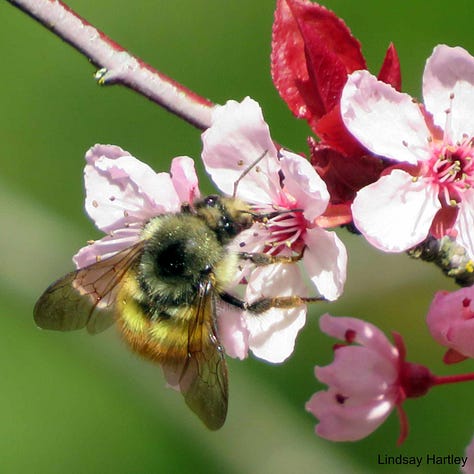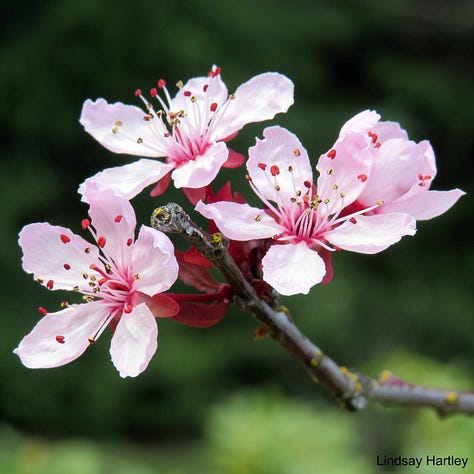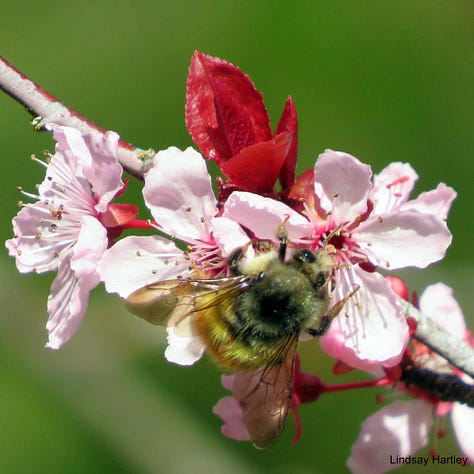Bumblebee, Busy Bee?
A fuzzy bumblebee nuzzles the flowers on an ornamental plum tree. Watching it makes me take pause, grateful for the beautiful colours and returning life after winter’s muted palette.
There are a number of bee species found on Vancouver Island, and I only began to learn about and to identify a one or two, a couple of years ago. One resource I came across at that time was local photographer Lynda Stevens’ beautiful and informative article and photos in Bumblebee Therapy (or How Bee Watching Kept Me Sane). Early last month I was thrilled to learn that Stevens, in conjunction with The Nanaimo and Area Land Trust (NALT), had just released an ID book - “Common Insect Pollinators: A Photographic Guide To Bees, Beetles, Butterflies, Flies, Moths and Wasps of Nanaimo and Area.” I picked up a copy as soon as I could. I had planned on sending out this newsletter admitting that I wasn’t quite sure which species was in the photo above. But by using this book, scrutinizing my various photos, and checking online at iNaturalist.org to see more of the variability within the species, I’ve concluded that this particular bee is a female Yellow-fronted Bumble Bee. “Common Insect Pollinators” is a great resource for central to south-east Vancouver Islanders, and I’m sure I will be using it often in the coming months and years. (For those interested, purchasing details are at the end of this section).
Watching bees buzzing from flower to flower, its easy to see where the saying “busy as a bee” came from. But the truth is, bees can actually spend a lot of time just resting or sleeping. Stevens compiled this tender little video of bumblebees sleeping in her flowers overnight. In “Bee Time: Lessons from the Hive,” author Mark L. Winston writes that honey bees “spend up to two-thirds of their lives doing nothing” – they are “resters” more than they are “workers” (p 174). While this statistic won’t apply to all bee species, it certainly gave me pause and had me rethinking my perception of these insects. As Winston continues, resting “has significant survival value by providing a reserve force for the inevitable, unpredictable challenges facing societies” (p 176). When under stress, bees rest less, work more and die sooner than those in a healthy, well adjusted hives.



Bees in general also have a unique strategy for conserving energy when they are working, based on the fact that bees have a positive charge while flowers have a negative one. A team at the University of Bristol, UK, has demonstrated that “when a bee visits a flower it transfers some of its positive charge, incrementally changing the flower’s field. With repeated visits, the charge may alter significantly, which could tell other bees that the nectar supply has been diminished” (Heaven, D). Thus bees can make smart choices as to which flowers to visit and which to bypass for awhile.
As members of a society that focuses so much on productivity, we can learn a lot from these energy conserving creatures. Personally, the next time anyone - including my inner critic - calls me lazy, I plan on retorting that “I’m being a busy as a bee.” I invite you to do the same.
References:
Lynda Stevens’ book “Common Insect Pollinators: A Photographic Guide To Bees, Beetles, Butterflies, Flies, Moths and Wasps of Nanaimo and Area” is available for purchase for $20 from NALT, 140 Wallace Street, Nanaimo. (250) 714-1990. It is 6” x 9”, 68 pages, and coil bound. According to this FB post, the book “…is designed for readers who have no previous experience in identifying insects. It contains 200 large, clear, colour photographs and tips on identifying these pollinators.” The back of the book notes that “Many of the selected species can be seen across central and south-east Vancouver Island as well as the Nanaimo area.”
Winston, Mark L. Bee Time: Lessons from the Hive. Cambridge, MA. Harvard University Press, 2014.
Heaven, Douglas. “Flowers get an electrifying buzz out of visiting bees.” New Scientist. February 27, 2013. https://www.newscientist.com/article/mg21729064-700-flowers-get-an-electrifying-buzz-out-of-visiting-bees/ Accessed November 8, 2023
Sweet Dreams, Welsh Pony Foal
Out for his daily jog in a rural area, a friend of my dad’s noticed a pony in labour in a field. He promptly alerted the property owners and they welcomed this little beauty into the world. A few weeks later I stopped by to see the little guy. Other people in the neighbourhood where also stopping by and I was warned to watch out for his teeth. It didn’t take me long to experience why (good thing for clothing!). He was as cute as could be though, with a brown body and startling blue eyes. A dark little shadow at his grey mom’s side, he was having fun exploring his little corner of the world - nosing, sniffing and nibbling his visitors, fence, and field. When he got tuckered out, he lay down in the sunshine, put his little nose in the grass and dozed off.
I’m sure you’ll feel even more tenderness towards this little one when you learn that the pony mare had saved from the meat buyers at an auction, and the new owner didn’t find out until later that the mare was pregnant. Thus, two little lives were given a second chance that day.
This April, I hope you find time to take a nap and daydream in the sunshine. After all, you need to rest to ‘bee’ your best. In May, I’ll invite you to join me for a virtual stroll in a beautiful park on Nanaimo’s waterfront where we’ll spot a White-crowned sparrow and some other birds; and I’ll tell you about a couple of special Siamese cats.
FYI - Starting in June, I am probably going to split my single monthly newsletter into two separate posts, sending out the Nature one on the 1st of each month and the Horses/Pets on the 7th or 15th. This would make the second topic easier to discover and share, as anyone accessing these via a cell phone can only see half of the title and could be completely unaware of the second topic unless or until they open it up. Does shorter but more frequent posts/emails work for you? I’m open to your feedback.
Blessings to you,
Lindsay










